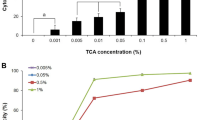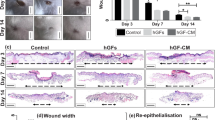Abstract
Objective: Salivary gland secretions play an important role in promotion of wound healing. The healing of intra- or extra-oral wounds is delayed in desalivated rats. However, the specific role of each salivary gland in promoting wound healing is unknown. This study was aimed to investigate the effect of crude extracts of rat salivary glands on a simplified in vitro wound healing model. Design/methods: Cultured human keratinocytes (HaCat) and murine fibroblasts (3T3) were subjected to 48 h serum starvation, and were later activated by extracts of rat salivary glands, 1–10 μg protein/ml of each gland. The resultant cellular metabolic activity of the activated cells was determined 24 h later, measuring reduction of XTT by mitochondrial enzymes, and calculated relatively to positive controls [optimal supplementation of 10% fetal calf serum (FCS)], and negative controls (starved non-supplemented cells). Results: The relative stimulatory effect of parotid (P) extract on the cells was significantly lower than either submandibular (SM) or sublingual (SL) extracts. Under the assumption that physiologically, the cells are exposed to the combined effect of saliva secreted from all the glands, different combinations of the extracts were presented to the cells. The relative stimulation was maximal following treatment with the three glands extracts (P + SM + SL) and exceeded the effect of 10% FCS. Conclusion: The results suggest that each salivary gland has a specific effect on wound healing and the combination of the three extracts has an additive effect but no the sum of all individual glands. This model might be useful to study the wound healing effect of salivary glands.
Similar content being viewed by others
References
Bodner L. 1991. Effect of parotid, submandibular, and sublingual saliva on wound healing in rats. Comparative Biochemical Physiology 100A: 887–890.
Bodner L. and Dayan D. 1991. Effect of sialadec to my on oral mucosa and skin wound healing in rats. Journal Head Neck Pathology 9: 229–231.
Bodner L. and Dayan D. 1995. Epithelium and connective tissue regeneration during palatal wound healing in desalivated Physiology 111A: 415–419.
Bodner L., Dayan D., Oberman M., Hirshberg A. and Tal H. 1992. Healing of experimental wounds in desalivated rats. Journal of Clinical Periodontology 19: 345–347.
Bodner L., Dayan D., Pinto Y. and Hammel I. 1993. Characteristics of palatal wound healing in desalivated rats. Archives of Oral Biology 38: 17–21.
Bodner L., Dayan D., Rothchild D. and Hammel I. 1991a. Extraction wound healing in desalivated rats. Journal of Oral Pathology Medicine 20: 16–18.
Bodner L., Knyszynski A., Adler-Kunin S. and Danon D. 1991b. The effect of selective desalivation on wound healing in mice. Experimental Gerontology 26: 357–363.
Boukamp P., Petrussevska R.T., Breitkreutz D., Hornung J., Markham A. and Fusenig N.E. 1988. Normal keratinization in spontaneously immortalized aneuploid human keratino-cyte cell line. Journal of Cell Biology 106: 761–771.
Bowen W.H., Pearson S.K. and Young D.A. 1988. The effect of desalivation on coronal and root surface caries in rats. Journal of Dental Research 67: 21–23.
Brosin A., Wolf V., Mattheus A. and Heise H. 1997. Use of XTT-assay to assay the cytotoxicity of different surfactants and metal salts in human keratinocytes (HaCaT). A feasible method for in vitro testing of skin irritants. Acta Derm. Venereol. (Stockh) 77: 26–28.
Cohen S. 1962. Isolation of a mouse submaxillary gland protein accelerating incision eruption and eyelid opening in newborn mice. Journal of Biological Chemistry 237: 1555–1562.
Fujisawa K., Miyamoto Y. and Nagayama M. 2003. Basic fibroblast growth factor and epidermal growth factor reverse impaired ulcer healing of the rabbit oral mucosa. Journal of Oral Pathology and Medicine 32: 358–366.
Graves L.M., Bornfeldt K.E. and Krebes E.G. 1997. Historic perspectives and new insights involving the MAP kinase cascades. Advances Second Messenger Phosphoprotein Research 31: 49–61.
Grossman N., Schneid N., Reuveni H., Halevy S. and Lubart R. 2000. He–Ne (633 nm) low power laser irradiation stimulates proliferation of keratinocytes cultures involving reactive oxy-gen species. Lasers Life Science 9: 111–126.
Game S.M., Huelsen A., Patel V., Donnelly M., Yeudall W.A., Stone A., Fusenig N.F. and Prince S.S. 1992. Progressive abrogation of TGF-beta 1 and EGF growth control is associated with tumor progression in ras-transfected human keratinocytes. International Journal of Cancer 52: 461–470.
Hutson J.M., Niall M., Evans D. and Fowler R. 1979. Effect of salivary glands on wound healing contraction in mice. Nature 279: 793–795.
Lee Y.-S., Yuspa S.H. and Dlugosz A.A. 1998. Differentiation of culture human epidermal keratincoytes at high cell densities is mediatedbyendogenous activationof proteinkinase Csignaling pathway. Journal of Investigative Dermatology 111: 762–766.
Morasca L. and Erba E. 1986. Flow cytometry in animal cell culture. In: Freshney R.I. (ed.), Animal Cell Culture: A Practical Approach. IRL Press, Oxford, England, pp. 125–148.
Ohshima M., Sato M. and Otsuka K. 2002. Physiologic levels of epidermal growth factor in saliva stimulate cell migration of an oral epithelial cell line, HO-1-N-1. European Journal of Oral Science 110: 130–136.
Oxford G.E., Tayari L., Barfoot M.D., Peck A.B., Tanaka Y. and Humphreys-Beher M.G. 2000. Salivary EGF levels reduced in diabetic patients. Journal of Diabetes Complications 14: 140–145.
Royce L.S. and Baum B.J. 1991. Physiologic levels of salivary epidermal growth factor stimulate migration of an oral epithelial cell line. Biochemical Biophysica Acta 1092: 401–403.
Scudiero D.A., Shoemaker R.H., Paull K.D., Monks A., Tierney S. and Nofziger T.H. 1988. Evaluation of a soluble tetrazolium/formazan assay for cell growth and drug sensitivity in culture using human and other tumor cell lines. Cancer Research 48: 4827–4833.
Shen I., Ghvamazadeh G. and Shklar G. 1979. Gingival healing in sialadenectomized rats. Journal of Periodontology 50: 533–539.
Singer A.J. and Clark R.A. 1999. Cutaneous wound healing. New England Journal of Medicine 34: 738–746.
Shiraha H., Gupta K., Drabik K. and Wells A. 2000. Aging fibroblasts present reduced epidermal growth factor (EGF) responsiveness due to preferential loss of EGF receptors. Journal of Biological Chemistry 275: 19343–19351.
Skinner K.A., Soper B.D. and Tepperman B.L. 1984. Effect of sialoadenectomy and salivary gland extracts on gastrointestinal mucosal growth and gastrin levels in rat. Journal of Physiology 351: 1–12.
Stephens P., Davies K.J., Occleston N., Pleass R.D., Kun C., Daniels J., Khaw P.T. and Thomas D.W. 2001. Skin and oral fibroblasts exhibit phenotypic differences in extracellular matrix reorganization and matrix metalloproteinase activity. British Journal of Dermatology 144: 229–237.
Todaro G.J. and Green H. 1963. Quantitative studies of the growth of mouse embryo cells in culture and their development into established cell lines. Journal of Cell Biology 17: 299–313.
Young G. 1981. Composition of saliva in mammals. Austrian Journal of Experimental Biology and Medical Science 59: 1–59.
Zelles T., Purushotham K.R. and Exford G. 1995. Salivary and growth factors: the fountain of youth resides in us all. Journal of Dental Research 74: 1826–1832.
Author information
Authors and Affiliations
Rights and permissions
About this article
Cite this article
Grossman, N., Binyamin, LA. & Bodner, L. Effect of Rat Salivary Glands Extracts on the Proliferation of Cultured Skin Cells – A Wound Healing Model. Cell Tissue Banking 5, 205–212 (2004). https://doi.org/10.1007/s10561-004-4367-7
Issue Date:
DOI: https://doi.org/10.1007/s10561-004-4367-7




